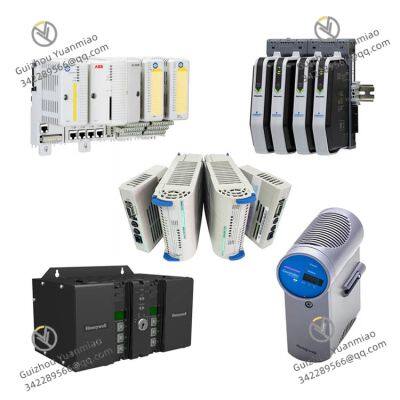Descri??o do produto
I. Vis?o Geral do Produto
PROVIBTECH TM591-B00-G00 é um transmissor de vibra??o de alto desempenho especificamente projetado para atender à demanda de monitoramento de vibra??o de equipamentos de alta precis?o em ambientes industriais complexos. Sua fun??o principal é converter com precis?o as vibra??es mecanicas geradas durante a opera??o do equipamento em sinais elétricos padr?o para integra??o perfeita com vários sistemas de aquisi??o de dados, sistemas de controle avan?ados e instrumentos de monitoramento profissionais.
Adotando conceitos de design inovadores e processos de fabrica??o sofisticados, este transmissor oferece excepcional confiabilidade e estabilidade, permitindo opera??o estável a longo prazo em condi??es industriais rigorosas e variáveis, como alta temperatura, alta umidade e forte interferência eletromagnética. Seu design estrutural compacto facilita muito a instala??o e integra??o em vários tipos de equipamentos. Se for usado para construir um sistema de monitoramento de vibra??o eficiente para novos equipamentos ou para atualizar sistemas de monitoramento de equipamentos existentes, ele se adapta excepcionalmente bem, fornecendo forte suporte para a opera??o estável e manuten??o eficiente do equipamento.
II. Principais Características
A. Desempenho de Sensoriamento de Ultra-Alta Precis?o
O TM591-B00-G00 está equipado com um sensor piezoelétrico de alta qualidade, que possui sensibilidade extraordinária e pode captar com precis?o mudan?as de vibra??o extremamente sutis. Sua precis?o de medi??o atinge impressionantes ±0.3% F.S. (Escala Total), representando uma grande inova??o em precis?o em compara??o com produtos similares.
Essa precis?o excepcional significa que, durante a medi??o de vibra??o do equipamento, ele pode fornecer dados altamente precisos, estabelecendo uma sólida base de dados para os usuários fazerem julgamentos precisos sobre o status de opera??o do equipamento. Por exemplo, no monitoramento de vibra??o de equipamentos de fabrica??o eletr?nica ultra-precisos, este transmissor pode detectar com precis?o mudan?as sutis de vibra??o causadas por fatores como movimento desbalanceado de pequenos componentes internos. Ele ajuda os engenheiros a identificar potenciais riscos de falha em tempo hábil e a tomar medidas de manuten??o direcionadas com antecedência, evitando efetivamente defeitos de qualidade do produto causados por vibra??es microscópicas acumuladas e garantindo altas taxas de rendimento de produtos eletr?nicos e a continuidade dos processos de produ??o.
B. Opera??o com Extremo Baixo Ruído
Os ambientes práticos de produ??o industrial est?o cheios de vários sinais de interferência, o que representa um sério desafio para a pureza da saída de sinal dos transmissores de vibra??o. O TM591-B00-G00 resolveu completamente esse problema durante a fase de design. Através da otimiza??o profunda dos circuitos internos e da aplica??o de tecnologias avan?adas de anti-interferência e algoritmos de supress?o de ruído, ele reduziu com sucesso o nível de ruído para<2μg rms, reaching an industry-leading standard.
This excellent feature allows the transmitter to stably and accurately output pure vibration signals even in complex electromagnetic environments (e.g., equipment around substations) or industrial sites with high background noise (e.g., workshops of large textile factories). It effectively avoids the adverse impact of external interference on the accuracy and reliability of monitoring data, ensuring high precision in equipment operating status monitoring.
C. Comprehensive Multi-Axis Measurement Function
This transmitter is equipped with a unique and powerful multi-axis measurement capability, enabling simultaneous accurate measurement and analysis of vibrations in three axes (X, Y, Z). During the actual operation of industrial equipment, equipment vibration often exhibits complex multi-dimensional movement patterns, and single-axis measurement data cannot fully and truly reflect the overall vibration status of the equipment.
The multi-axis measurement function of TM591-B00-G00 perfectly compensates for this deficiency. By comprehensively collecting and in-depth analyzing vibration data from the three axes, users can gain a comprehensive and three-dimensional understanding of the equipment's operating status and accurately determine whether there are potential fault risks in the equipment. Taking the engine of a large ship as an example, it generates complex vibrations in multiple directions during operation due to factors such as hull swaying and the interaction of mechanical components. The multi-axis measurement function of this transmitter can fully capture such vibration information, providing rich and detailed data support for the health monitoring and maintenance of ship engines and helping to ensure the safety and stability of ship navigation.
D. Ultra-Wide Measurement Range with Flexible Adaptability
To meet the diverse and personalized needs for vibration measurement ranges in different industrial application scenarios, TM591-B00-G00 offers an extremely wide and flexible measurement range, from as low as 0.01g to as high as 100g, covering the vibration measurement range of most industrial equipment.
Whether it is used for monitoring precision optical instruments that are highly sensitive to vibration amplitude, or for monitoring heavy mining machinery with intense vibrations, it can achieve accurate measurement with ease thanks to its excellent range adaptability. This ensures that reliable and accurate data can be obtained from vibration monitoring of equipment of different types and under different working conditions, providing key data support for the stable operation and effective maintenance of equipment.
E. Diverse Output Options
Advantages of High-Quality Output Signals
The transmitter provides an industry-standard 4-20mA high-quality output signal. This signal type has strong anti-interference capabilities, enabling it to maintain signal stability and accuracy throughout long-distance transmission and effectively reducing the risk of signal attenuation and distortion.
The 4-20mA output signal design greatly facilitates connection and integration with various mainstream data acquisition systems, intelligent controllers, and other industrial automation equipment. Users can easily achieve efficient collection and convenient processing of vibration data without the need for additional complex signal conversion and conditioning circuits. For example, in the automated production line of a large intelligent factory, vibration data from various key equipment is output as 4-20mA signals through the TM591-B00-G00 transmitter, which can be directly connected to the central control system. This enables real-time, centralized monitoring and intelligent management of the vibration status of equipment across the entire production line, providing strong support for the efficient and stable operation of the production process.
Adaptability of Multiple Output Options
In addition to the 4-20mA current output, TM591-B00-G00 also thoughtfully provides a variety of rich output options, including 0-10V voltage output and RS485 digital interface output.
The 0-10V voltage output is suitable for specific application scenarios that are sensitive to voltage signals or require simple analog control, and can provide intuitive and convenient control signals for related equipment. The RS485 digital interface offers stronger data transmission capabilities and longer transmission distances, facilitating high-speed and stable data communication with computers, high-end data recorders, and other equipment, and enabling more advanced and complex data processing and in-depth analysis functions.
For instance, in a scientific research laboratory environment, researchers can quickly and accurately transmit vibration data to a computer through the RS485 interface, and use professional analysis software for in-depth data mining and complex model establishment, providing accurate data support for the smooth progress of scientific research projects. In small-scale automated control systems that require high real-time performance and control precision, the 0-10V voltage output can be directly used to precisely control the operating status of related equipment, making immediate and accurate adjustments based on equipment vibration conditions to ensure the stability and efficiency of system operation.
F. Top-Tier Protection Level Guarantee
Excellent Dust and Water Resistance
TM591-B00-G00 features an IP68 top-tier protection level. In terms of dust resistance, it achieves a fully sealed state, completely preventing dust from entering the interior of the equipment. This effectively avoids corrosion, short circuits, and other damage to internal electronic components caused by long-term dust accumulation, significantly extending the service life of the equipment and ensuring stable operation in dusty industrial environments (such as cement plants and coal mining areas).
In terms of water resistance, it can be continuously submerged in 2 meters of water for up to 72 hours without any impact. Even in harsh environments with long-term humidity and water exposure (such as offshore drilling platforms and core equipment areas of sewage treatment plants), it can reliably perform vibration monitoring tasks, providing stable and reliable data support for continuous monitoring of equipment operating status and strongly ensuring the continuity and stability of vibration monitoring work.
Reliable Explosion-Proof Safety Performance
This transmitter also holds an Exia IIC T6 high-standard explosion-proof rating, allowing it to be safely and stably used in hazardous areas with high-risk factors such as flammable and explosive gases, vapors, or dust. In industries such as petrochemicals, natural gas extraction, and underground coal mining, there are many non-negligible explosion risks in the equipment operating environment.
The explosion-proof design of TM591-B00-G00 fundamentally and effectively prevents explosion accidents caused by electric sparks, high temperatures, and other factors generated by the equipment itself through the use of special explosion-proof materials, optimized electrical structures, and strict safety certification processes. It provides a safe and reliable solution for equipment vibration monitoring in these hazardous areas, effectively safeguarding the safety of personnel and equipment assets.

III. Technical Parameters
A. Core Measurement Characteristics
Measurement Accuracy: ±0.3% F.S., far exceeding the high-precision indicators of similar products, laying a solid foundation for the accurate evaluation of equipment vibration status.
Noise Level:<2μg rms, achieving extreme low-noise output to ensure the purity and reliability of monitoring data in complex environments.
Number of Measurement Axes: 3 axes (X, Y, Z), fully covering the demand for multi-dimensional vibration information collection of equipment and truly reflecting the complete vibration profile of the equipment.
Measurement Range: 0.01g - 100g, featuring an ultra-wide range design to flexibly adapt to vibration measurement scenarios of various industrial equipment with different vibration amplitudes.
B. Electrical Performance Parameters
Output Signals: Provides multiple output formats including 4-20mA, 0-10V, and RS485, meeting the interface requirements of different equipment and system integration needs.
Power Supply Voltage: Standard DC24V (can be appropriately adjusted according to specific application scenarios and customized requirements), compatible with a wide range of industrial power supply systems.
Signal Transmission Distance: When using the 4-20mA output signal, a reliable transmission distance of up to 1000 meters can be achieved under conventional industrial cable conditions, effectively reducing the impact of signal attenuation on data accuracy; the RS485 interface can achieve a transmission distance of up to 1200 meters in high-speed transmission mode, meeting the needs of long-distance and large-volume data transmission.
C. Mechanical and Environmental Adaptability Characteristics
Operating Temperature Range: Features an extremely wide operating temperature adaptability range, from -50℃ to +100℃. It can operate stably in harsh environments such as extreme cold (e.g., polar scientific research equipment) and extreme heat (e.g., equipment near high-temperature furnaces in steel mills), ensuring that equipment vibration monitoring is not affected by ambient temperature.
Vibration Resistance: Its structural design provides excellent vibration resistance, capable of withstanding external impact vibrations of up to 50g without affecting its measurement accuracy. Even in industrial sites with extremely complex and intense vibration environments (e.g., around large vibrating screen equipment), it can still stably output accurate vibration measurement data.
Protection Level: IP68 for top-tier dust and water resistance, providing all-round protection for the equipment against dust and water erosion; Exia IIC T6 explosion-proof rating, offering reliable guarantee for safe use in hazardous environments, ensuring stable operation of the equipment in various harsh and high-risk environments.
IV. Functions and Working Principles
A. Accurate Vibration Signal Collection and Efficient Conversion
The operation of TM591-B00-G00 starts with the accurate collection of equipment vibration signals. Its internal core piezoelectric sensor quickly detects dynamic changes in mechanical stress when the equipment generates vibrations. Based on the advanced piezoelectric effect principle, piezoelectric materials generate an electric charge on their surface quickly and accurately when subjected to external forces, and the amount of charge is proportional to the external force.
Therefore, any subtle changes in the vibration amplitude and frequency of the equipment will be efficiently converted into corresponding changes in electrical signals through the piezoelectric sensor. However, these initial electrical signals are usually weak and easily mixed with a large amount of environmental noise and self-interference signals. Subsequently, these original electrical signals are immediately sent to the carefully designed signal conditioning circuit module of the transmitter.
In the signal conditioning circuit, through a series of advanced processing procedures such as multi-stage high-gain amplification, precision filtering, and intelligent signal calibration, the original electrical signals are efficiently and stably converted into industrial-standard output signals, such as 4-20mA current signals, 0-10V voltage signals, or high-speed digital signals output through the RS485 interface. This provides a high-quality signal source for subsequent data collection, analysis, and processing by external equipment.
B. Stable Data Transmission and Diverse Application Expansion
The high-quality signals after conversion and conditioning can be transmitted to external equipment through multiple reliable methods. When using 4-20mA or 0-10V analog signal output, it can be directly connected seamlessly to various mature data acquisition modules, PLC (Programmable Logic Controller) analog input modules, and other equipment.
After receiving the signals, these receiving devices can quickly and accurately analyze and process the vibration data based on preset intelligent algorithms and precise thresholds. For example, they can real-time determine whether the equipment is in normal operating status, and immediately trigger the alarm system to notify relevant personnel to take response measures once the vibration value exceeds the preset normal range.
If signals are output through the RS485 digital interface, a high-speed data communication link can be conveniently established with computers, high-end data recorders, intelligent monitoring terminals, and other equipment. On the computer side, users can use powerful professional monitoring software to perform comprehensive real-time monitoring, long-term storage, in-depth mining and analysis of vibration data, as well as generate intuitive and visualized reports and charts.
Through advanced data analysis methods such as trend analysis, spectrum analysis, and fault feature extractA análise da tendência dos dados de vibra??o ao longo de um período de tempo permite prever com precis?o o momento em que o equipamento pode falhar. Planos de manuten??o científicos e razoáveis podem ser formulados com antecedência, reduzindo efetivamente a probabilidade de falhas repentinas do equipamento, melhorando a eficiência operacional geral e a confiabilidade do equipamento e fornecendo forte suporte para a estabilidade e eficiência da produ??o e opera??o da empresa.
ABB LD 810HSE EX Dispositivo de Liga??o de Barramento de Campo
Sistema de Monitoramento de Vibra??o Vibro-Meter VMF-RLC16-V111200-570-101-015
Vibro-Meter VMF-IOC4T 200560-101-017 Sistema de Monitoramento de Vibra??o
TRICONEX D28799-005 Módulo de Alimenta??o Elétrica
TRICONEX 7400213-100 Unidade de Execu??o de Hardware de Sinal Digital
Módulo de seguran?a de entrada digital de densidade TRICONEX DI3361


Módulo de Saída TRICONEX DO3401
Módulo de Saída Analógica TRICONEX AO3482
ABB GRID BREAKER UNIT GBU72 3BHB030310R0001
TRICONEX CM2201 7400206-100 Baseplate do Módulo de Comunica??o
TRICONEX DI2301 7400208-020 Baseplate de Entrada Digital
TRICONEX AI2361 7400210-020 Módulo de Seguran?a de Entrada Analógica
TRICONEX AT-2701FX 843-000844-00 REVD Módulo de Cart?o de Entrada/Saída
BENTLY NEVADA 330901-05-32-05-02-00 Módulo de Monitoramento de Vibra??o
BENTLY 330103-00-03-10-02-05 Sonda de Proximidade
BENTLY 330130-085-02-05 Cabo de Extens?o
BENTLY 330704-000-050-10-02-05 Sondas de Proximidade
BENTLY NEVADA 330104-00-05-10-02-CN Sondas de Proximidade
BENTLY NEVADA 330108-91-05 Sonda de Proximidade
BENTLY NEVADA 330780-90-05 Sonda de Proximidade
BENTLY 330180-X1-CN Sonda de Proximidade
BENTLY 24765-02-00 Sistemas de Transdutores de Expans?o
BENTLY 22810-01-05-50-02 Sonda de Proximidade de Vibra??o
GE IS200EGPAG1BCA Placa do Amplificador do Pulso da Porta do Excitador
GE IS200EPSMG1AEC Módulo de Fontes de Alimenta??o do Excitador
ABB PPD513A-23-111615 controlador de excita??o magnética
Sistema Instrumentado de Seguran?a (SIS) TRICONEX módulo de controle 4351B
Bentley Nevada 3500/22M Módulo de interface de dados transientes
Bently Nevada 3500/15-05-05-00 módulo de energia
 yezi
Olá! Bem-vindo(a) à minha loja. Avise-me se tiver alguma dúvida.
yezi
Olá! Bem-vindo(a) à minha loja. Avise-me se tiver alguma dúvida.


